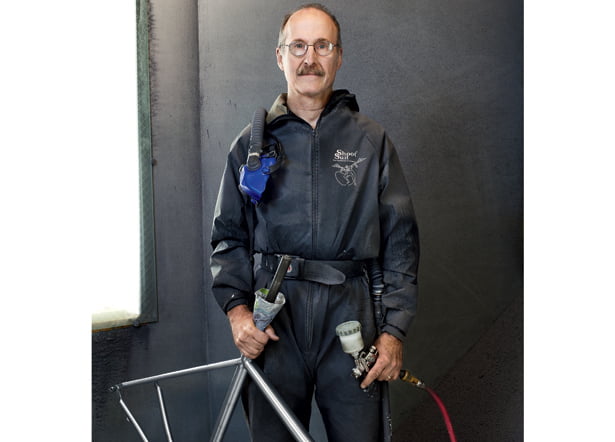Today, the competition to build frames that are ever lighter, stiffer, and more aerodynamic has made carbon composites the most desired material for performance road bikes. But to some of the grand masters of bike building, and to a select number of revered engineers and designers who have tried all the materials, there is still nothing quite like titanium.
“You can use body English with a ti bike because it has some springiness that lets the bike react to you,” says Rob Vandermark, who created that iconic Extra Light. “With a stiffer bike, particularly newer carbon bikes, the stiffness initially feels really good, but there’s no interaction.”
Vandermark, an early employee at Merlin Cycles and founder of Seven Cycles, has a nearly unmatched pedigree in custom-bike circles. One person at his level is Tom Kellogg, whose frames were ridden to two professional world championships and 20 national titles between 1977 and 1980, a track record that led to his collaboration with Vandermark on the Extra Light. Among custom and production builders, Kellogg’s own Spectrum bikes are some of the most respected in the world—even though they’re made with the untrendy gray metal. He points to ti’s nonlinear modulus as the source of the metal’s unique ride: That characteristic means the more force you apply, the harder it becomes to bend. “If you try to bend a piece it will at first give a little,” says Kellogg. “But the further you try to flex it, the more resistant it becomes.” On the road, that trait means you know exactly what’s going on at the intersection of your tire and the pavement—a sensation demanded by performance-oriented riders—but the initial flex means you’re not bothered by rough pavement. Bikes made from steel, aluminum, and carbon can also achieve that result, it’s just that titanium does so with a blend of ride sensations nothing else quite matches, kind of like the way any alcoholic beverage can get you inebriated but only a single-malt Scotch possesses its distinctive, refined combination of tastes.
Tom Kellogg, the man behind Spectrum Cycles, helped to modernize Ti frames. (Joshua Simpson)

Vandermark and Kellogg also point to ti’s longevity—the metal does not rust or corrode, is less likely to be damaged in a crash than bikes made from other materials, and has a longer fatigue life than steel or aluminum. But those are additional benefits, nice qualities to get in a new bike, rather than an abiding reason to buy one. Put simply: It’s all about the ride. We tested five custom bikes to find out if that mysterious, magic ride feel still stands out in the era of carbon. And we found ourselves in agreement with Vandermark, who told us, “Ti will never be back to its former heyday, but we’re seeing it becoming a larger share of our business at Seven. There’s some backlash against the limitations of the carbon ride as the material is pushed to be as light and stiff as possible. It’s great to see good riders enjoy titanium bikes in a way that stiffer frames just won’t allow.”
[“source-bicycling”]





